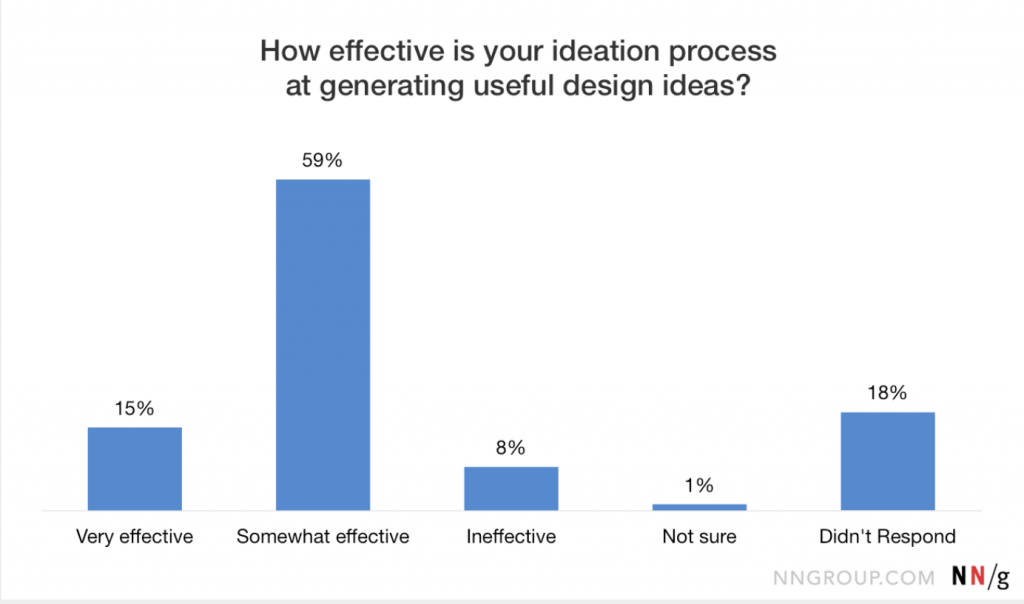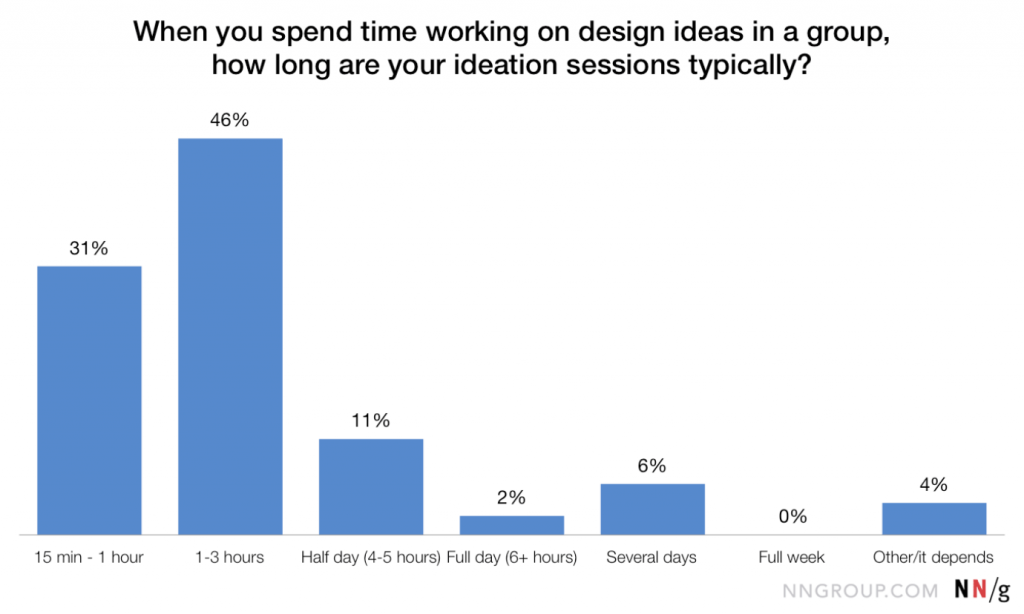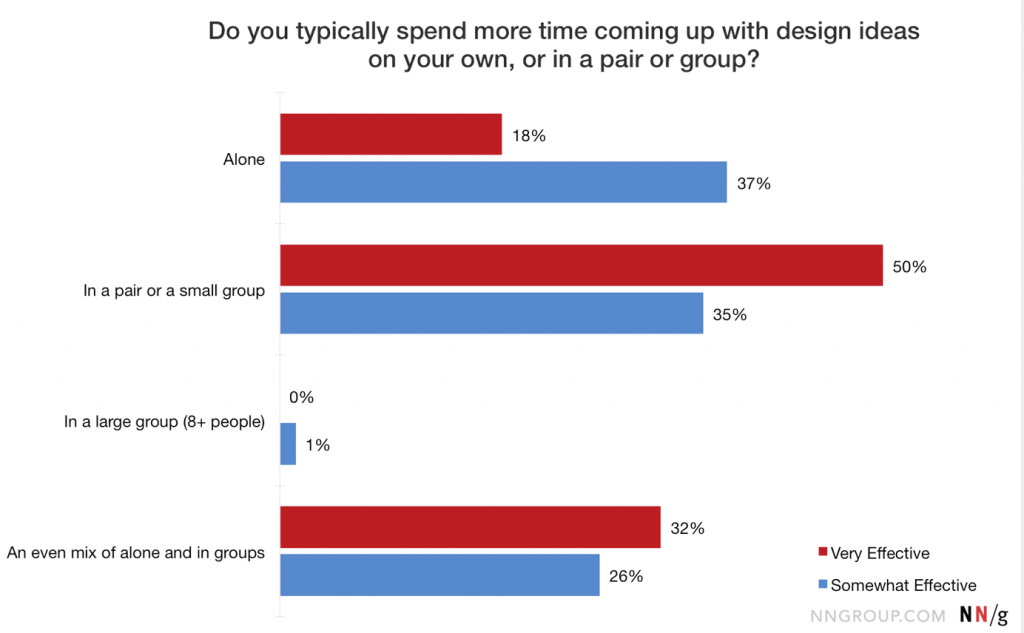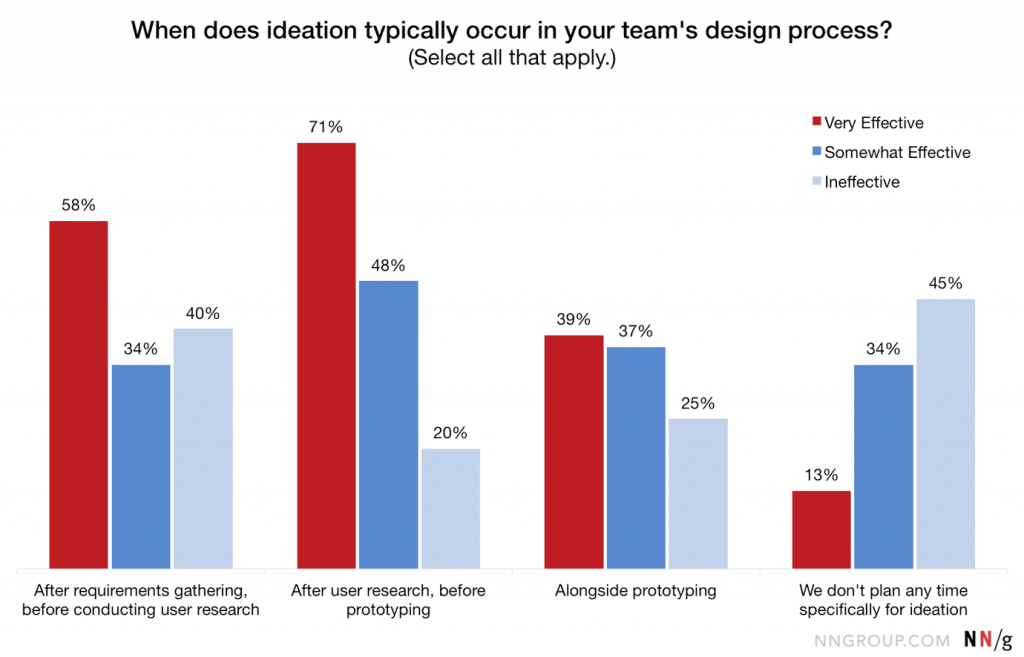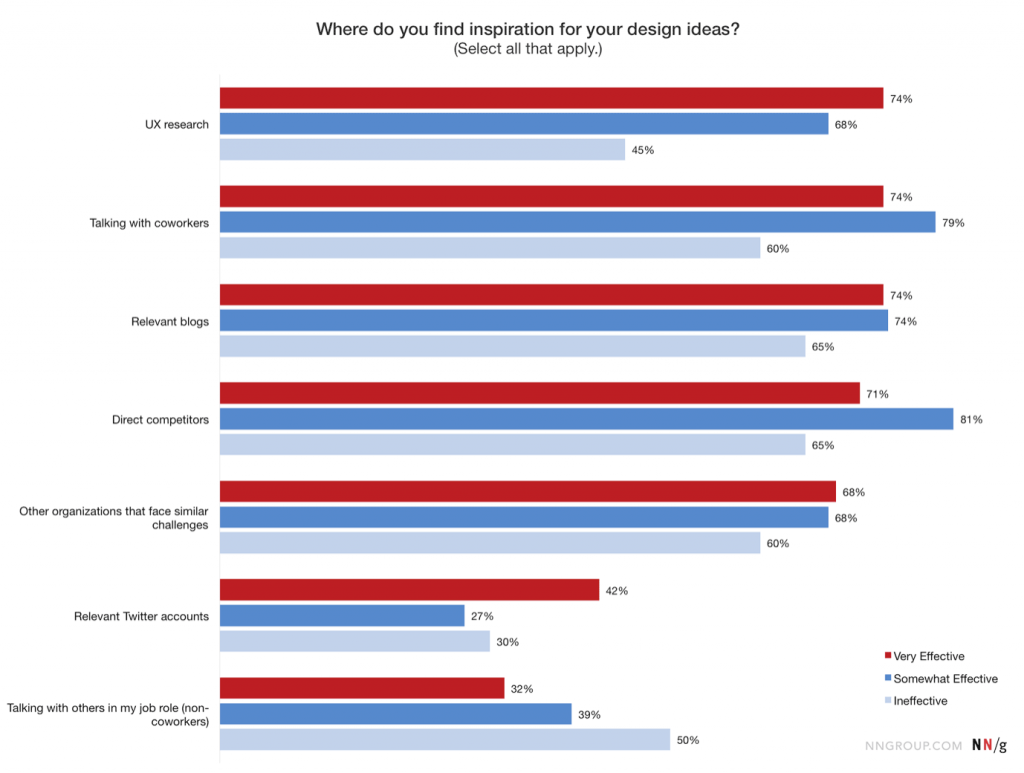The ideation is probably one of the most delicate stages of the design phase of a product. Often overlooked for fear of getting lost, product teams or designers only venture into this unknown territory with great reserve.
At UX-Republic, we are convinced, this is a highly strategic moment in the process of user-centered design. This is why, on mission or through our Digital Training Center, we particularly insist on this step, whether for the interface design or a service through the Design Thinking.
For these reasons, we share with you the translation of a survey led by Aurora Harley, User Experience Specialist @Nielsen/Norman Group. Good reading …
Ideation: How Effective UX Teams Generate Ideas
The ideation phases vary according to the number of people involved and the techniques used. In order to have a better understanding of how a designer approaches this stage, his challenges and his choice of methods, we surveyed 257 professionals in the field (in SMEs and large accounts): UX-Designers, Developers, Content Strategist , UI Designers and Product Managers.
Ideation effectiveness
Only 15% of respondents think their ideation process is “very effective”.
A majority (59%) consider its process to be only “moderately effective”. 8% “admit” that their process is “inefficient”. Finally, 18% do not answer the question. So we can add them to the “inefficient” category (why else wouldn't they want to answer this question?)
A majority of professionals consider their processes to be only “moderately effective”.
Structure of the ideation session
Duration of the session
For 31% of respondents, a typical ideation session lasts 15 minutes to 1 hour. For 46% of them, from 1 to 3 hours. Thus, 77% of respondents need less than 3 hours to carry out an ideation session!
The majority of ideation sessions last less than 3 hours, and often less than 1 hour.
Number of participants in ideation sessions
Most respondents indicate that they avoid large group sessions. 99% of them conceptualize on their own or in small groups of less than eight people. This is not surprising, as large groups are more difficult to channel.
So how many people should be included?
You don't need a lot of people to come up with a lot of ideas.
40% of specialists generate ideas in small groups of two to eight people, 34% do so alone and 25% alternate between group and solo sessions.
Is individual ideation more effective than in a group?
Comparing the “highly effective” and “moderately effective” segments, we find that the latter contains a greater proportion of solitary ideators (37%) than the “highly effective” segment (18%).
People who find their ideation process to be very effective in generating good design ideas tend to do it in groups.
This result corroborates the response of 66% of respondents who indicated that thegroup ideation is more efficient.
Those with highly effective idea generation processes collaborate more often than others.By including more people in your ideation process, you can generate a wider range of ideas.
The challenges of ideation
An observable trend in this large sample is unanimity about the challenges of ideation.
Lack of time
The main challenge (for 19% of respondents) is the fact of not having enough time to spend on ideation during design cycles. This is not only a lack of time for the ideation itself, but also the impossibility of carrying out user studies to fully understand their needs before and after the ideation sessions.
“Pressure to choose a design quickly. »
“The pace of Agile engineering leaves no time for UX in the product development cycle. »
“Clients prefer to pay for development rather than design, let alone ideation. »
Nothing surprising here, but it is surprising that so many professionals find it difficult to devote enough time to UX, while ideation does not necessarily take a long time. (Reminder: 77% of respondents take less than 3 hours for an ideation session.)
Finally, our analysis of the duration of ideation sessions shows that teams with an effective process do not spend more time on it than others. The important thing is therefore not the amount of time you spend, but how you use it.
Lack of support from the hierarchy
Lack of time for ideation and design exploration in the project schedule is an indicator of low senior management support, which is the case for 15% of respondents. Without this support, teams have a hard time persuading other team members to join their ideation sessions.
“Colleagues don't see the point of the ideation phase, they're too busy. »
“It's difficult to make people aware of the importance of this phase, and that they give us time. »
“It's hard to get our colleagues from other departments to sit around the same table. »
These sentiments echo our previous survey of UX processes as a whole, where we noted that the UX received less support from the hierarchy than the other teams. This is particularly the case for ideation, where the support and influence of the hierarchy is decisive in the involvement of other teams offering different perspectives in the generation of creative solutions.
Lack of user studies
13% of respondents felt they didn't have enough time to conduct user studies in order to contextualize their ideation session or test their ideas. This problem is intimately linked to the lack of time, resources and support from the hierarchy.
While it is important to devote time to the ideation itself, we should not neglect the studies with users. Without these, even if you have many ideas, it is not guaranteed that they will lead to relevant designs if they are not anchored in the reality of the users.
Due to lack of time or money, designers sometimes tend to base their design decisions on their own experience. In the absence of reliable data, this seems a logical solution, except that you are not the end user !
“In the absence of studies, we only have differing opinions. »
“We don't know who our user is or what their needs or problems are. »
“We need to have a common base before conceptualizing. »
I know I'm preaching here to converts. Also, I will content myself with sharing links with you on how to combine UX and Agile, on how to justify the need to focus studies on users and tips for create respect for UX.
Group dynamic issues
The majority of respondents also indicated having problems with group dynamics: 69% said that at the end of some ideation sessions, some people felt frustrated, angry, or felt like they had been ignored.
When is the ideal ideation moment?
The timing of ideation within the design process can largely determine its effectiveness.
32% of respondents do not set a specific time for ideation.Some don't have time for ideation, while others don't plan it or give it official status in the design process. It thus takes place at different stages of the design, including when a prototype has already been produced.
For those whose ideation process is “very effective”, it most often takes place at the beginning of the design cycle. Additionally, 71% of them were conducting an ideation session after conducting user research, but before creating a prototype.
Professionals whose ideation session is very effective most often take place at the very beginning of the design cycle.
Ideation does not necessarily have to be confined to a single stage of design, but the sooner the better : once you have a prototype, the design trajectory is more or less established and you will not be able to take advantage of divergent solutions. Thus, it is better to organize your ideation sessions before developing a solution prototype.
Ideation methods
The ideation methods used vary from one company to another, and that's good! There is no miracle recipe for ideation. NOTfeel free to adapt the idea generation techniques to the requirements of your project.
There are many sources of inspiration, including competition (78%), colleagues (76%), blogs (73%), companies with similar challenges (68%) and UX studies (67%).
Pom those whose ideation process is “very effective”, 74% are inspired by UX studies.
Against 68% of those with a “moderately effective” process and 45% of those whose method is “ineffective”.
As for the methods used during ideation sessions, many of those surveyed explained that they had totally open discussions. Less than half use techniques to structure ideation.
Without going so far as to say that a casual discussion is irrelevant, it is useful to indicate here that it is about the method chosen by 95% of respondents whose process was ineffective. Their second method is brainstorming (28% of them).
So if a team is struggling to generate original ideas, it may be useful to give more structure to the conceptualization process through ideation techniques.
Take Away
Here are the best practices that emerged from our study of UX Design processes:
- Carry out ideation early in the design cycle
- Involve several stakeholders in the ideation session
- Get Inspired from several sources including user studies
- Use structured ideation techniques
- To have un trained facilitator
- Timeboxer the sessions
For more advice on ideation and to try out structured techniques that facilitate idea generation, take part in our trainings on Design Thinking, Lean-UX and l'UX design.
Source
Ideation in Practice, Aurora Harley, October 2017, Nielsen/Norman Group
Context: Sébastien Faure, Learning & Development Manager – Head of Content @UX Republic / Translation: Eric Bossin
FOR FURTHER
[actionbox color=”default” title=”” description=”Get trained in Analytics & UX during an exceptional training in collaboration with the Nielsen Norman Group ” btn_label=”view the Program” btn_link=”http://training.ux-republic.com/ux-certification-nielsen-norman-group/” btn_color=”primary” btn_size=”big” btn_icon=”star” btn_external =”1″]
[row] [one_third]

[/one_third] [two_third]
UX-CERTIFIED®
by Nielsen Norman Group
From 12 to 16 November 2018
UX-Republic – Paris Saint-Lazare
For the first time in France, UX-Republic Digital Training Center offers you, in its premises in Paris, a new training in collaboration with Nielsen Norman Group.
[/two_third] [/row]

